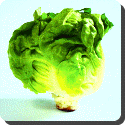 Lettuce, Crisphead and Leaf — The Lettuce (Lactuca sativa) is a temperate annual or biennial plant of the daisy family Asteraceae. It is most often grown as a leaf vegetable. In many countries, it is typically eaten cold and raw, in salads, hamburgers, tacos, and many other dishes. In some places, including China, lettuce is typically eaten cooked and use of the stem is as important as use of the leaf. Both the English name and the Latin name of the genus are ultimately derived from lac, the Latin word for “milk”, referring to the plant’s milky juice. Mild in flavour, it has been described over the centuries as a cooling counterbalance to other ingredients in a salad. However it has been humorously described by filmmaker John Waters in his humorous essay, 100 Things I Hate. He refers to iceberg lettuce as “the polyester of greens”.
Lettuce, Crisphead and Leaf — The Lettuce (Lactuca sativa) is a temperate annual or biennial plant of the daisy family Asteraceae. It is most often grown as a leaf vegetable. In many countries, it is typically eaten cold and raw, in salads, hamburgers, tacos, and many other dishes. In some places, including China, lettuce is typically eaten cooked and use of the stem is as important as use of the leaf. Both the English name and the Latin name of the genus are ultimately derived from lac, the Latin word for “milk”, referring to the plant’s milky juice. Mild in flavour, it has been described over the centuries as a cooling counterbalance to other ingredients in a salad. However it has been humorously described by filmmaker John Waters in his humorous essay, 100 Things I Hate. He refers to iceberg lettuce as “the polyester of greens”.
The lettuce plant has a short stem initially (a rosette growth habit), but when it blooms the stem lengthens and branches, and it produces many flower heads that look like those of dandelions, but smaller. This is called bolting. When grown to eat, lettuce is harvested before it bolts. Lettuce is used as a food plant by the larvae of some Lepidoptera.
Of the many varieties of lettuce, Lettuce sativa, the most popular include crisphead and oak leaf. Unlike the other types, the oak leaf is a loose-leaf variety and does not form a true head. Each lettuce is subtly differentiated in flavor and texture.
Crisphead, also called Iceberg, which form tight, dense heads that resemble cabbage. They are generally the mildest of the lettuces, valued more for their crunchy texture than for flavour. Cultivars of iceberg lettuce are the most familiar lettuces in the USA. The name Iceberg comes from the way the lettuce was transported in the US starting in the 1920s on train-wagons covered in crushed ice, making them look like icebergs.
 Kids Portal For Parents India Kids Network
Kids Portal For Parents India Kids Network






